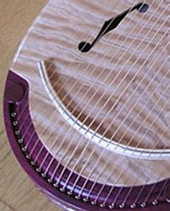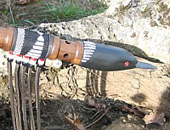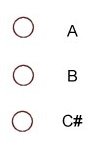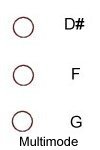Multi Mode Versus Traditional Tuning |
To easiest way to demonstrate the basic difference between these two tunings is to look at the fingering diagram below, using your curser to see the changes between them. With your curser OFF the diagram, you can see the MULTIMODE tuning where each single fingering hole is tuned to a specific note. If you direct your curser onto the diagram as though you are going to cover the fourth fingering hole, the diagram will change to the tuning of the TRADITIONAL (Mode 1) flute. |
||||
F#
(Fundamental)
Blow Hole End |
||||
|
With the Mode 1 tuning displayed you will see that it takes two fingering holes (open) to create the upper octave of the fundamental. With Multimode tuning the upper octave of the fundamental is played by covering fingering hole #5 (not demonstrated by the diagram). The majority of flute makers create Mode 1 (Traditional) flutes and it is this style of tuning that most players are familiar with. The practice of keeping the fourth fingering hole covered with this style of tuning is often taught by many instructors and, indeed, is published in the majority of books that teach flute playing. The fourth fingering hole is often referred to as the 'forbidden' fingering hole because it is kept covered at all times so, basically, you are playing a five fingering hole flute. Because Mode 1 tuning uses two fingering holes to create the upper octave, their tuning has to be compromised because, mathematically, they cannot play both their individual notes as well as the upper octave fundamental. To best understand this it needs to be appreciated that all notes are based on the note of A being equal to a frequency value of 440 Hertz (Hz). The next note in the chromatic scale (as every note of a piano is tuned) will be A#. Mathematically the difference between A & A# is 24.69 Hz plus 5.96%. This totals to 26.16 Hz. The sum for A# will then be 440 plus 26.16 = 466.16. The next note is B which is calculated by taking 26.16 Hz and increasing it by a further 5.96%. This totals to 27.72 Hz. If you then take the frequency value of the note before (A#) and add its value (466.16 Hz) you will arrive at a frequency of 493.88 which is B. To continue further, the next note is C so the calculation will be: B = 493.88 Hz Add the increase between A# and B of 27.72 Hz and add an additional 5.96% which amounts to 27.72 Hz plus a further 5.96% = 29.37 Hz.. So, B = 493.88 plus 29.37 = 523.25 Hz. which is the frequency for C. If you now consider the formula above, the frequencies for G & F are: G = 783.99 Hz F = 698.46 Hz Similarly the frequency for F# is 739.99 Hz When the fourth fingering hole of a TRADITIONAL flute is covered the two notes, F & G, are averaged. This means that the frequencies of 783.99 and 698.46 are added together and then divided by 2. This gives an average frequency of 741.23 Hz for the upper octave F#. However, the true frequency for F# is 739.99 Hz. In order for the flute maker to create an accurate F# at a frequency of 739.99 Hz, either the G or the F fingering hole has to be different from their true value. For example, if the flute maker adjusts the G note the frequency for that note would have to be: G = 781.52 F = 698.46 To demonstrate this, take both the value of F and the compromised value of G (781.52 Hz) and find the average of them both: 781.52 plus 698.46 = 1,479.98. Average this by dividing by 2 = 739.99 Hz (the correct frequency for F#) The above shows how the G fingering hole has to be 'out tuned' from its correct frequency of 783.99 Hz to 781.52 Hz in order to achieve a true F# upper octave note of 739.99 Hz and this will hopefully explain why so many flutes play sour notes at the higher end of their tuning. As each flute maker will tune the upper two fingering holes to their own style of flute making variations in fingering tabs will appear on Native American inspired Flute tablature music and this also explains the reason why this is. With the Multimode tuning there is NO forbidden fingering hole which creates several advantages. Firstly, there are no 'averaged' notes. Each note is accurately tuned at 400Hz. The second advantage is that the F# upper octave note falls between the fingering holes for F and G. F is the fifth fingering hole, so if you cover it the note above, G, will halve itself quite naturally. This means that the note of G will reduce itself to F#. This tuning is true and accurate. There are no averages or compromises! All flute tablature music is constant with multimode tuning and without alternate fingerings! |
Table of Frequencies
| The mathematical formula for calculating frequencies can be difficult to understand so I have created the table below using a simple compound formula so that you can see how frequencies increase/decrease by the sum shown in column 3 and/or the amount shown in column 4. | |||||
1 |
2 |
3 |
4 |
5 |
6 |
Note |
Hertz |
Addition |
Total Column 3 |
(1) Decimal Place Rounding |
Next Higher Note (Hertz) Column 2 + 4 - 5 |
C4 (2) |
261.63 |
14.66 + 5.96% |
15.53 |
+0.02 |
277.18 = C#4 |
C#4 |
277.18 |
15.53 + 5.96% |
16.46 |
+0.02 |
293.66 = D4 |
D4 |
293.66 |
16.46 + 5.96% |
17.44 |
+0.03 |
311.13 = D#4 |
D#4 |
311.13 |
17.44 + 5.96% |
18.48 |
+0.02 |
329.63 = E4 |
E4 |
329.63 |
18.48 + 5.96% |
19.58 |
+0.02 |
349.23 = F4 |
F4 |
349.23 |
19.58 + 5.96% |
20.75 |
+0.01 |
369.99 = F#4 |
F#4 |
369.99 |
20.75 + 5.96% |
21.99 |
+0.02 |
392.00 = G4 |
G4 |
392.00 |
21.99 + 5.96% |
23.30 |
- |
415.30 = G#4 |
G#4 |
415.30 |
23.30 + 5.96% |
24.69 |
+0.01 |
440.00 = A4 |
A4 |
440.00 |
24.69 + 5.96% |
26.16 |
- |
466.16 = A#4 |
A#4 |
466.16 |
26.16 + 5.96% |
27.72 |
- |
493.88 = B4 |
B4 |
493.88 |
27.72 + 5.96% |
29.37 |
- |
523.25 = C5 |
C5 |
523.25 |
29.37 + 5.96% |
31.12 |
- |
554.37 = C#5 |
C#5 |
554.37 |
31.12 + 5.96% |
32.97 |
-0.01 |
587.33 = D5 |
D5 |
587.33 |
32.97 + 5.96% |
34.93 |
-0.01 |
622.25 = D#5 (Eb5) |
D#5 |
622.25 |
34.93 + 5.96% |
37.01 |
- |
659.26 = E5 |
E5 |
659.26 |
37.01 + 5.96% |
39.21 |
-0.01 |
698.46 = F5 |
F5 |
698.46 |
39.21 + 5.96% |
41.54 |
-0.01 |
739.99 = F#5 |
F#5 |
739.99 |
41.54 + 5.96% |
44.01 |
-0.01 |
783.99 = G5 |
G5 |
783.99 |
44.01 + 5.96% |
46.63 |
-0.01 |
830.61 = G#5 |
G#5 |
830.61 |
46.63 + 5.96% |
49.40 |
-0.01 |
880.00 = A5 |
A5 |
880.00 |
49.40 + 5.96% |
52.34 |
-0.01 |
932.33 = A#5 |
A#5 |
932.33 |
52.34 + 5.96% |
55.45 |
-0.01 |
987.77 = B5 |
B5 |
987.77 |
55.45 + 5.96% |
58.75 |
-0.02 |
1,046.50 = C6 |
(1) Frequency values extend far beyond the decimal point so rounding variances occur with all calculations that are restricted to 2 decimal places. This column adjusts these small variances. (2) Know as 'Middle C' due to its position on an 88 key Piano. |
|||||









